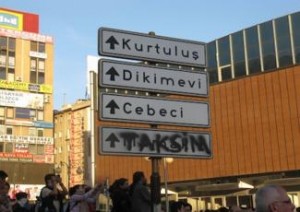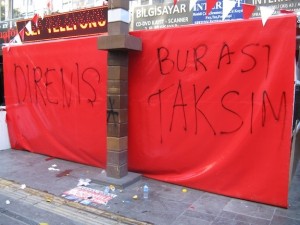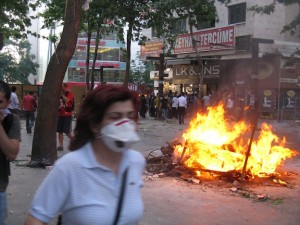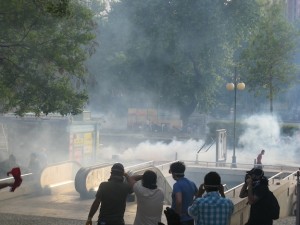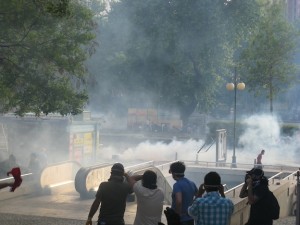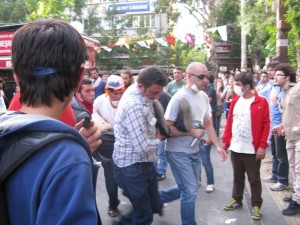It seemed the same thing was about to happen with Gezi Park, the last green area of Taksim Square. We were watching television desperately, feeling anxious that the same thing would happen to the park as happened to Emek. A few people were protesting in Gezi, staying day and night and trying to resist the cutting down of trees.
The day that police brutally assaulted the resisters and burned down their tents was the turning point, and was also the historical moment for Ankara, and the whole country as well. On Friday, 31 May, the people of Ankara rose up against the assault. People gathered in Kuğulu Park (Swan Park), which is one of the symbols of Ankara, and protested against police violence and government repression. People brought their flags and banners, shouting slogans: “Tayyip İstifa” (Tayyip Resign), “Faşizme Karşı Omuz Omuza” (Shoulder to Shoulder against Fascism) and “Her Yer Taksim, Her Yer Direniş” (Everywhere Is Taksim, Everywhere Is Resistance). The latter became the main slogan of all resistance in Ankara in the following days. So it can be said that at the beginning of the protests, the essential motivation was to show support and solidarity with the Gezi Park resistance.
However, those involved in the protests increasingly came to express their anger against the amalgam of neo-liberal and Islamist policies of the Adalet ve Kalkınma Partisi [AKP] government, as well as their mistrust of the AKP’s discourses regarding personal freedoms. The group of protesters has been very heterogeneous, representing a wide range of the political spectrum. There are socialists, Marxists, feminists, nationalists, Kemalists, LGBTs, liberals, football club supporters, and even some people who define themselves as “Anti-Capitalist Muslims” who have differentiated themselves from a political Islamist ideology. All of them were represented in the protests, and they were all against the current situation in Gezi. There was no single group in a leading position; in fact, no one wanted the political parties or workers’ syndicates or labor unions to be involved actively in the protests. The protesters defined themselves instead as “people” and they were opposed to labeling themselves with their political ideologies or parties, although they bring their own flags and shout their own slogans.
After three hours of protests on 31 May in Kuğulu, people decided to walk down Kennedy Street to Akay, which is the road that runs within a hundred meters of the National Assembly. At that point, a police blockade was waiting for them, intended to prevent any potential attempt to occupy the Assembly’s garden. After a one-hour protest in Akay, police attacked the protesters with tear gas and water cannons. This was the first violent action in Ankara in conjunction with the Gezi protests. People were forced to disperse onto other streets, and in a sense the police did succeed in putting an end to the protests in Akay and Kuğulu that day.
But the most striking event happened after midnight. In the neighborhood of Yüzüncüyıl, where I live, people suddenly began to open their windows and clank pots at 1:30am; some young people called out to the neighborhood to come to the street and start a new protest. When they began to gather in front of a supermarket and walk around the neighborhood, they were not more than a hundred people. However, after a while, neighborhood residents began to come down from their apartments to the street in their sleepwear and join the crowd; after one hour of walking, the crowd was countless. They were holding flags, shouting slogans, and banging pots. In fact, after the crowd grew to more than three thousand, they decided to walk to the Assembly once again.
But the police, one more time, put a blockade at Eskisehir Boulevard, and by five in the morning, the police assault on people with tear gas and water cannons began. Until that moment, no one knew how to cope with the impact of tear gas, which makes people blind and temporarily out of breath, and so makes it impossible to run away. When the crowd went back to their homes by early morning, they were much more angry and ready for another day of resistance.
Since Ankara is the capital city of Turkey, protests spreading through the city present an unbearable situation for the government. Istanbul was the capital city of the Ottoman Empire, and thus it can be argued that the historical and political importance of Ankara stems from being the capital city of the “young republic,” which is based on being a secular and modern nation-state. Ankara represents the rupture from the “old” imperial, theocratic state and the foundation of the “new” modern republic. Therefore, there was always a tension between the values that Ankara has been thought to bear and the values that the AKP, as the representative of a “conservative-democrat” political ideology with neo-Ottomanist tendencies, has tended to impose upon the country.
One of the biggest mosques of Ankara, Kocatepe Camii, which features a big supermarket on the ground floor, is a good example for understanding the desired transformation of Ankara by the government. The mosque was opened for worship by Turgut Özal in 1987, and it is worth bearing in mind that Recep Tayyip Erdoğan presents himself as the successor of Özal. During the time his government has been in power, the significance of Kocatepe considerably increased as the symbol of the AKP’s policies, with their mixture of neo-liberalism and Islam. The main axis of the center of the city has been moved to other neighborhoods, and Kızılay has become more and more insignificant.
In the first days of the protests, it was preferable from the government’s point of view to confine the protests to Istanbul (specifically to Gezi Park) and marginalize protesters there as “looters” in the eyes of public opinion, as Prime Minister Recep Tayyip Erdoğan did in several press conferences. In a sense, the government had valid reasons to think in this way: after the beginning of the Ankara resistance, new protests took place in more than sixty cities throughout Turkey, including some cities that are known as being particularly “conservative.” So Ankara was the key place to spread protests to whole country. As a result, the brutal police attacks were arguably more violent in this city than anywhere else.
By 1 June, the second day of the protests in Ankara, the atmosphere was much more tense and the government intended to quell the protests immediately by any means necessary. People were aware of the situation; on that day, there were clashes in every corner of Kızılay Square. But this time, people were ready to fight and had some solutions in order to decrease the impact of tear gas. There were suggestions in the social media for using mixtures such as milk, water, and “alcid,” which is an ordinary medicine for stomach-aches. Protesters have used this mixture when they are affected by tear gas; they spray it into their eyes or drink it in order to breathe easier. And everyone had masks, veils, and goggles to protect themselves and help others.
However, the police began to use tear gas canisters as “bullets,” aiming them directly at protesters’ bodies. Many people were wounded by the cannisters-cum-bullets, and some suffered severe head traumas or bone fractures.
Medical students from different universities came to the streets with their medical equipment and tried to help the injured; certain buildings were quickly converted into infirmaries. Several pubs and cafés distributed food, water, and milk without charging any money, and many businesses hid people to protect them from police custody. By the evening, the police had to withdraw from the square and let people in. Since no protests had been allowed by the government in Kızılay Square for many years (even for May Day), this was a very significant accomplishment for the resisters. People celebrated their “victory” all night in the Square, until the police threw new tear gas after midnight.
At the time this is being written, the protests and resistance hasve been going on for more than two weeks. During this time, the assault by the police in Ankara has never stopped, and in Ankara alone there have been more than five hundred people injured. In addition, a protester, Ethem Sarısülük, was killed after being shot in head by the real bullets of a police officer in Kızılay Square during demonstrations. After spending a week in a coma, he died on 5 June, and his family called for a ceremony in Kızılay. After the ceremony in Kızılay, the family planned bring the coffin to the Cemevi (the Alevi place of worship in Turkey) and then go to his hometown Çorum to bury him. However, the governor of Ankara did not give permission for the ceremony to proceed in Kızılay, and the police, once again, attacked the crowd there with tear gas and water cannons. Ethem’s family was forced to abandon its decision to hold a public ceremony. This event obviously denotes the intolerant behavior of the government in Ankara. Meanwhile, the police officer who killed Ethem Sarısülük continued his work in the protests for more than a week, and the government did not start any investigation of the killing until two days ago.
As an eyewitness, I can say that these protests have had a great effect on people in Ankara who have never experienced such a huge, persistent, and long-term resistance. I think the primary achievement so far has been the establishment of a deep solidarity and cooperation between individuals from different backgrounds and political ideologies. They have begun to hear each other’s voices, and to try to understand each other’s languages and gain a new way of moving together without discriminating against one another. By means of all this, the people who are resisting are more and more self-confident, and they trust in their power, which has already been enough to challenge a strong government.Önder Güneş
20 June 2013
Source: Jadaliyya

